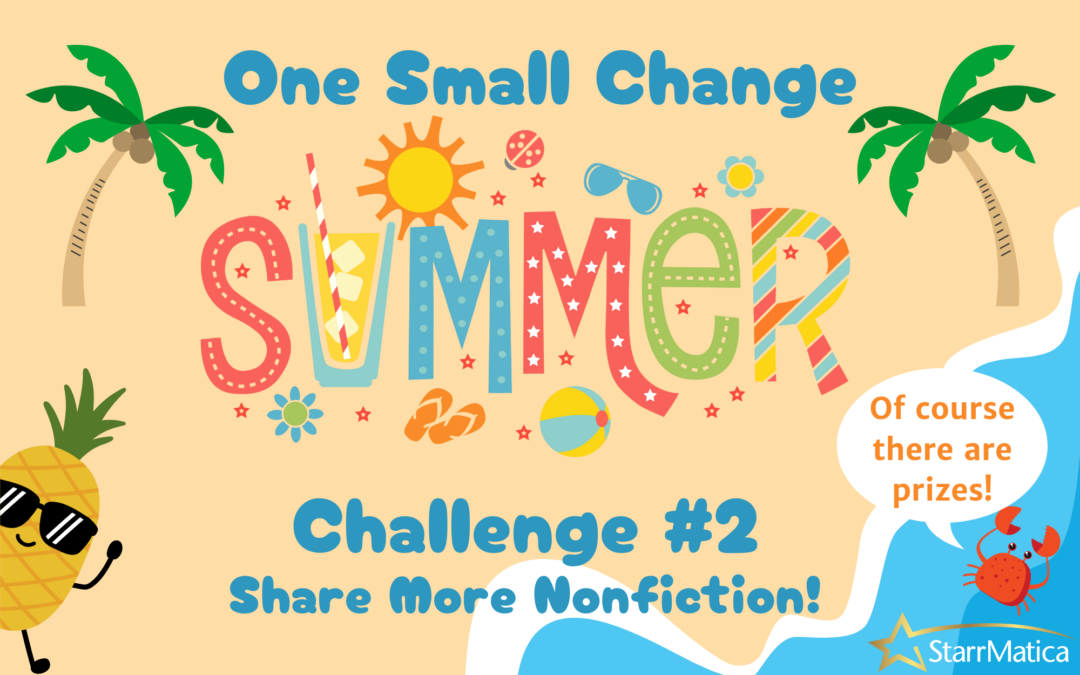New to the “One Small Change Summer Challenge?” Please read this blog post first!
You can find Challenge #1 here. (Reminder: You must complete all 7 challenges to be eligible for prizes on September 2nd!)
Part One:
Watch this short video excerpt from a longer class I offer about integrating scientific thinking and an engineering mindset into your daily classroom routine. In this video, you’ll discover why you should share more nonfiction picture books in your classroom:
Note: This video was removed on September 2nd at the end of the challenge.
Part Two:
- Find a nonfiction picture book published in the last five years that aligns with a topic in your curriculum and that you will be excited to share. If you haven’t explored nonfiction picture books much in the last few years, you are in for a treat! In addition to the texts I shared in the video, here are a few of my current favorites:
The Wolves of Yellowstone – A Rewilding Story by Catherine Barr – This book explores the interconnectedness of our natural world by sharing the story of the reintroduction of the grey wolf into Yellowstone Park.
- NGSS Curriculum Connection:
- 3-LS4-4: Make a claim about the merit of a solution to a problem caused when the environment changes and the types of plants and animals that live there may change.
- Science Question:
- What problems were caused by removing wolves from Yellowstone? Did their reintroduction fix those problems? How? What additional problems did their reintroduction cause? Should they have been reintroduced? Why or why not?
The Great Carrier Reef by Jessica Stremer – This is the story of a retired aircraft carrier that is turned into an artificial reef.
- NGSS Curriculum Connections:
- 3-LS4-3: Make a claim about the merit of a solution to a problem caused when the environment changes and the types of plants and animals that live there may change.
- 5-ESS3-1: Obtain and combine information about ways individual communities use science ideas to protect the Earth’s resources and environment.
- Science Question:
- Can this reef rebuilding technique solve the problem of dying coral reefs everywhere? Why or why not? What would be some of the constraints on replicating a project like this? (ie: Why can’t they sink ships everywhere to solve reef problems?)
Darwin’s Super Pooping Worm Spectacular by Polly Owen – Discover what makes earthworms spectacular through the experiments conducted by a worm-obsessed Charles Darwin.
- NGSS Curriculum Connection:
- K-ESS2-2 Construct an argument supported by evidence for how plants and animals (including humans) can change the environment to meet their needs.
- Science Question:
- How do earthworms make their environment better?
And here are links to lists of award-winning nonfiction picture books:
- American Library Association Siebert Award
- National Council of Teachers of English Orbis Pictus Award
- National Science Teachers Association Best STEM Books
- National Science Teachers Association Outstanding Science Trade Books
- To qualify for the prizes on September 2nd, please visit this Facebook Post and share in the comments:
- What book did you choose, and how does it fit in your curriculum?
- Why are you excited to share this book? What about it speaks to you?
- What scientific question(s) related to your curriculum could you ask as you read it aloud?
See you next Monday!


